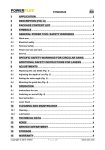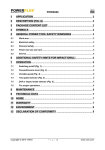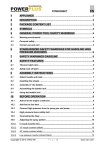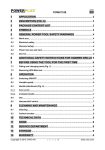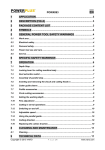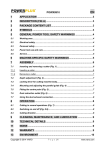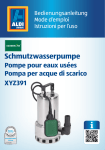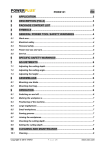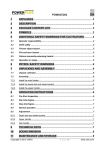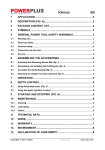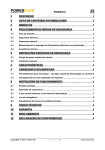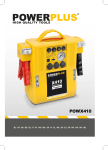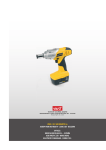Download Powerplus POWX0782 mitre saw
Transcript
POWX0782 EN 1 APPLICATION ................................................................................. 4 2 DESCRIPTION ................................................................................ 4 3 PACKAGE CONTENT LIST ............................................................ 4 4 SYMBOLS ....................................................................................... 5 5 GENERAL SAFETY WARNINGS ................................................... 5 5.1 Working area .......................................................................................................... 5 5.2 Electrical safety...................................................................................................... 5 5.3 Personal safety ...................................................................................................... 5 5.4 Power tool use and care ........................................................................................ 6 5.5 Service .................................................................................................................... 6 6 ADDITIONAL SAFETY INSTRUCTIONS FOR CROSS-CUT AND TABLE SAWS ................................................................................. 6 7 ELECTRICAL SAFETY ................................................................... 8 8 SPECIAL PRODUCT CHARACTERISTICS ................................... 8 9 INSTALLATION AND TRANSPORT .............................................. 9 9.1 Installation (Fig. 14) ............................................................................................... 9 9.2 Transport (Fig. 5, 12, 13) ........................................................................................ 9 9.2.1 Table saw operating mode (Fig. 2, 5, 6, 12) ............................................................. 9 9.2.2 Cross-cut and mitre saw operating mode (Fig. 6) ................................................... 10 9.2.3 Turntable (Fig. 7-9) ................................................................................................ 10 9.2.4 Adjustment of the bevelling angle (Fig. 10-11)........................................................ 10 9.2.5 Mitre and width guide (Fig. 12-13) .......................................................................... 10 9.2.6 Connection to a dust collector ................................................................................ 10 9.2.7 Connection to AC power ........................................................................................ 11 10 OPERATIONS ............................................................................... 11 10.1 Cross-cut sawing mode ....................................................................................... 11 10.1.1 Safety instructions for the movable saw blade guard (Fig. 16) ................................ 11 10.1.2 Safety lock (Fig. 2-3) .............................................................................................. 11 10.1.3 Installation (Fig. 12 and 13) .................................................................................... 11 10.1.4 Normal cross-cut operations .................................................................................. 12 10.1.5 Mitre sawing (Fig. 7)............................................................................................... 13 Copyright © 2015 VARO P a g e |1 www.varo.com POWX0782 EN 10.1.6 Bevelling (Fig. 10 and Fig. 11)................................................................................ 13 10.1.7 Sawing the workpiece: ........................................................................................... 13 10.1.8 Double mitre cut ..................................................................................................... 14 10.1.9 Sawing the workpiece: ........................................................................................... 14 10.2 Table saw mode ................................................................................................... 14 10.2.1 Safety instructions for the saw blade guard (Fig. 12) .............................................. 14 10.2.2 Riving knife (Fig. 12) .............................................................................................. 14 10.2.3 Lower saw blade guard (Fig. 12) ............................................................................ 14 10.2.4 Push block (Fig. 17 and 18) ................................................................................... 14 10.2.5 Installation.............................................................................................................. 15 10.2.6 Sawing ................................................................................................................... 16 11 CLEANING AND MAINTENANCE ................................................ 16 11.1 Cleaning ............................................................................................................... 16 11.2 Maintenance ......................................................................................................... 16 11.2.1 For all maintenance works ..................................................................................... 16 11.2.2 Before every use .................................................................................................... 16 11.2.3 Monthly (if the saw is used every day) .................................................................... 17 11.2.4 Every 300 operating hours (Fig. 10) ....................................................................... 17 11.2.5 Changing the saw blade (Fig. 19-21)...................................................................... 17 11.2.6 Tightening the drive belt ......................................................................................... 19 11.2.7 Checking the tension.............................................................................................. 19 11.2.8 Renewed tensioning (Fig. 23-26) ........................................................................... 19 11.2.9 Replacing the saw guide (21) ................................................................................. 19 11.3 Modifications ........................................................................................................ 20 11.3.1 Modifications on the mitre and width guide (Fig. 27) ............................................... 20 11.3.2 Modifications on the mitre scale indicator (Fig. 28) ................................................. 20 11.3.3 Modification of the bevelling angle indicator (Fig. 29) ............................................. 20 11.3.4 Adapting the sawing depth stop (Fig. 30) ............................................................... 20 11.4 Cleaning ............................................................................................................... 20 11.5 Storage ................................................................................................................. 20 12 TECHNICAL DATA ....................................................................... 21 13 NOISE ............................................................................................ 21 Copyright © 2015 VARO P a g e |2 www.varo.com 14 POWX0782 EN WARRANTY .................................................................................. 22 15 ENVIRONMENT ............................................................................ 22 16 DECLARATION OF CONFORMITY ............................................. 23 Copyright © 2015 VARO P a g e |3 www.varo.com EN POWX0782 CROSS-CUT AND MITRE SAW WITH TOP TABLE POWX0782 1 APPLICATION The machine is designed for sawing wood, metal and plastic. It is not designed for commercial use. WARNING! Read this manual and general safety instructions carefully before using the appliance, for your own safety. Your power tool should only be passed on together with these instructions. 2 DESCRIPTION 1. 2. 3. 4. 5. 6. 7. 8. 9. 10. 11. 12. 13. 14. Upper sawing table Riving knife Saw blade guard Mitre and width guide Locking knob for the mitre and width guide Safety lock ON/OFF switch Switch A Mitre locking knob Indicator, mitre scale Mitre table Base Guide Lower saw blade guard 15. 16. 17. 18. 19. 20. 21. 22. 23. 24. 25. 26. 27. 28. 29. Indicator, bevelling scale Bevelling lock Table scale Saw blade Sawing head Switch Saw guide Locking knob Mitre index Push block Workpiece clamp Hexagonal spanner Exhaust pipe Dustbag Switch B 3 PACKAGE CONTENT LIST Remove all packaging materials. Remove remaining packing and package inserts (if included). Check that the package contents are complete. Check the appliance, the power cord, the power plug and all accessories for transportation damage. Keep the packing materials as far as possible till the end of the warranty period. Dispose it into your local waste disposal system afterwards. WARNING: Packaging materials are not toys! Children must not play with plastic bags! Danger of suffocation! Mitre and width guide Push block Workpiece clamp Hexagonal spanner Exhaust pipe Dustbag Manual If any parts are missing or damaged, please contact your dealer Copyright © 2015 VARO P a g e |4 www.varo.com POWX0782 EN 4 SYMBOLS In this manual and/or on the machine the following symbols are used: In accordance with essential Denotes risk of personal requirements of the European injury or damage to the tool. directive(s) Read manual before use "Class II - The machine is double insulated; Earthing wire is therefore not necessary Wear eye protection Wear gloves Do not touch a turning saw blade. 5 GENERAL SAFETY WARNINGS Read all safety warnings and instructions. Failure to heed warnings and follow instructions may result in electric shock, fire and/or serious injury. Keep safety warnings and instructions for future reference. The term "power tool" in the safety warnings refers to your mainsoperated (corded) power tool or battery-operated (cordless) power tool. 5.1 Working area Keep working area clean and well lit. Untidy and dark areas can lead to accidents. Do not operate power tools in potentially explosive surroundings, for example, in the presence of inflammable liquids, gases or dust. Power tools create sparks which may ignite the dust or fumes. Keep children and bystanders at a distance when operating a power tool. Distractions can cause you to lose control of it. 5.2 Electrical safety Power tool plugs must match the outlet. Never modify the plug in any way. Do not use adapter plugs with earthed power tools. Unmodified plugs and matching outlets will reduce the risk of a lethal electric shock. Avoid body contact with earthed surfaces such as pipes, radiators, kitchen ranges and refrigerators. There is an increased risk of a lethal electric shock if your body is earthed. Do not expose power tools to rain or wet conditions. If water gets inside a power tool, it will increase the risk of a lethal electric shock. Do not damage the cord. Never use the cord for carrying, pulling or unplugging the power tool. Keep the cord away from heat, oil, sharp edges or moving parts. Damaged or entangled cords increase the risk of a lethal electric shock. When operating a power tool outdoors, use an extension cable suitable for outdoor use. Using a cord suitable for outdoor use reduces the risk of a lethal electric shock. 5.3 Personal safety Stay alert, watch what you are doing and use common sense when operating a power tool. Do not use a power tool when you are tired or under the influence of drugs, alcohol or medication. A moment of inattention when operating a power tool may result in serious personal injury. Use safety equipment. Always wear eye protection. Using safety equipment such as a dust mask, non-skid safety shoes, a hard hat, or hearing protection whenever it is needed will reduce the risk of personal injury. Copyright © 2015 VARO P a g e |5 www.varo.com EN POWX0782 Avoid accidental starts. Ensure the switch is in the off position before inserting the plug. Carrying power tools with your finger on the switch or plugging in power tools when the switch is in the on position makes accidents more likely. Remove any adjusting keys or spanners before turning on the power tool. A spanner or key left attached to a rotating part of the power tool may result in personal injury. Do not reach out too far. Keep your feet firmly on the ground at all times. This will enable you retain control over the power tool in unexpected situations. Dress properly. Do not wear loose clothing or jewellery. Keep your hair, clothing and gloves away from the power tool. Loose clothes, jewellery or long hair can become entangled in the moving parts. If there are devices for connecting dust extraction and collection facilities, please ensure that they are attached and used correctly. Using such devices can reduce dust-related hazards. 5.4 Power tool use and care Do not expect the power tool to do more than it can. Use the correct power tool for what you want to do. A power tool will achieve better results and be safer if used in the context for which it was designed. Do not use the power tool if the switch cannot turn it on and off. A power tool with a broken switch is dangerous and must be repaired. Disconnect the plug from the power source before making adjustments, changing accessories, or storing power tools. Such preventive safety measures reduce the risk of starting the power tool accidentally. Store power tools, when not in use, out of the reach of children and do not allow people who are not familiar with the power tool or these instructions to operate it. Power tools are potentially dangerous in the hands of untrained users. Maintenance. Check for misalignment or jammed moving parts, breakages or any other feature that might affect the operation of the power tool. If it is damaged, the power tool must be repaired. Many accidents are caused by using poorly maintained power tools. Keep cutting tools sharp and clean. Properly maintained cutting tools with sharp cutting edges are less likely to jam and are easier to control. Use the power tool, accessories and cutting tools, etc., in accordance with these instructions and in the manner intended for the particular type of power tool, taking into account the working conditions and the work which needs to be done. Using a power tool in ways for which it was not intended can lead to potentially hazardous situations. 5.5 Service Your power tool should be serviced by a qualified specialist using only standard spare parts. This will ensure that it meets the required safety standards. Damaged switches must be replaced by our after-sales service department. If the connecting cable (or mains plug) is damaged, it must be replaced by a special connecting cable which is available from our service department. Replacement of the connecting cable should only be carried out by our service department (see last page) or by a qualified specialist (qualified electrician). 6 ADDITIONAL SAFETY INSTRUCTIONS FOR CROSS-CUT AND TABLE SAWS Always wear eye protectors. Never use the equipment in the presence of flammable liquids or gases. NEVER use the equipment when a cutting disc (and not a saw disc) has been attached. Before each use, check the saw blade for small cracks or damages. Replace a cracked or damaged blade immediately. Never use saw blades made of high-speed steel (HSS). Copyright © 2015 VARO P a g e |6 www.varo.com POWX0782 EN Only use saw blades that are recommended by the manufacturer and that fulfil the EN8471 standard. Also make sure the riving knife is not thicker than the width of the saw cut, and that it is not thinner than the body of the saw blade. Always use the accessories that are recommended by this manual. Select the correct saw blade for the material must be sawn. To reduce the generation of noise, always make sure that the blade is sharp and clean. Only use correctly sharpened saw blades. Never exceed the maximum speed that is indicated on the saw blade. Before installing the saw blade, clean the axle, the flanges (especially the assembly surfaces) and the hexagonal nut. Incorrect mounting can lead to vibrations/knocking or slipping of the saw blade. Wherever possible, use the saw guard and the riving knife with every type of application, also when sawing material in two. Always mount the saw guard according to the instructions in this manual. Cutting operations are those where the saw blade cuts completely through the workpiece, such as for instance when doing longitudinal cuts or shortening workpieces. NEVER use the equipment with a defective saw guard, and never tie up the saw guard with a rope or cord. Every irregularity in the operation of the saw guard must be immediately corrected. Immediately replace the saw guard and the riving knife, after a process has been completed that required their removal. Prevent that the saw comes into contact with metals, such as nails and screws. Search for and remove all nails, screws and other foreign materials from the workpiece, before you start to work. Remove spanners, cut off pieces and the other items from the saw table, before turning on the switch. NEVER wear gloves while working; the wearing of gloves is only recommended while cutting tools are being replaced. Make sure that your hands stay clear of the cutting line of the saw blade. NEVER stand in the cutting line of the saw blade and NEVER let anyone else stand in that position. Make sure that the saw blade does not touch the riving knife or the workpiece, before you turn on the switch. Let the saw run for a few moments before inserting a workpiece. Listen for vibrations or knocking of the saw blade, which can indicate improper mounting or balancing of the blade. The equipment may not be used for making grooves or recesses. Replace the table insert when it is worn out. NEVER make any adjustments on the machine while it is turning. Remove the plug from the socket before making any adjustments. If necessary, use a push block. A push block MUST be used for longitudinal sawing of smaller workpieces, so that your hands and fingers are kept well away from the saw blade. Always store your push block, whenever it is not in use. Pay special attention to the instructions that help to reduce the hazard of KICK BACK. KICK BACK is a sudden reaction to a jammed, bent or badly aligned saw blade. KICK BACK causes the workpiece to be thrown back in the direction of the operator. KICK BACK can lead to serious injuries. KICK BACK can be avoided by keeping your saw blade sharp, by keeping the rip fence parallel to the saw blade, by maintaining the riving knife and the saw guard in good condition and in the right position, by keeping a good grip on the workpiece until you have pushed it completely past the saw blade, and by not sawing any twisted or skewed wood pieces, or pieces that do not have a straight edge for moving along the rip fence, in a longitudinal direction. Copyright © 2015 VARO P a g e |7 www.varo.com POWX0782 EN Do not carry out any free-hand operations. Free-hand means that you use your hands for supporting the workpiece, or for leading it with your hands, instead of using the rip fence or the mitre block. NEVER bend over or around the saw blade. NEVER reach for a workpiece, before the saw blade has come to a complete stop. Avoid a sudden or too quick infeed of a workpiece. Workpieces made of hard material should be fed in as slowly as possible. Never fold or turn a workpiece while feeding it into the saw. If the saw blade jams or ceases to turn while the workpiece is being fed in, turn the equipment off immediately. Remove the plug from the socket. Remove the piece that is blocking the saw. NEVER try to remove sawed off chips, and never touch the saw guard, as long as the saw blade is turning. Remove all lose knots from the workpiece, BEFORE starting to saw. Do not maltreat the cable. Never pull on the cable, for removing the plug from the socket. Do not expose the cable to heat, oil, water or sharp edges. Some types of dust that is generated while working with the saw may contain chemicals, which can cause cancer, birth defects or other genetic damages. Some examples of these substances are: Lead derived from paints containing lead; Arsenic and chrome from chemically treated wood. The hazard to your health from such exposures is dependent on how frequently you do this kind of work. Measures for reducing your exposure to such chemicals: Always work in well-ventilated surroundings and with certified safety equipment, such as dust masks that have been specially designed for filtering out microscopic particles. For sawing operations, connect the equipment to a dust exhaust system. The guard may be lifted up while positioning a workpiece, or for easier access during maintenance works. Make sure that the saw guard has been lowered and is positioned flat against the sawing table, before connecting your tool to the mains supply. 7 ELECTRICAL SAFETY Check the voltage that is documented on the type plate of the machine, to make sure that it corresponds to the locally available mains voltage.Safety class II. 8 SPECIAL PRODUCT CHARACTERISTICS Quick change-over between cross-cut and table saw mode. 90° sawing range for bevelling (45° left or 45° right) with five preset stops 110° sawing range for mitre sawing (50° left or 60° right) with ten preset stops Perfectly suited for mobile use, due to its low weight and small dimensions Robust, cast aluminium construction for precision sawing TCT saw blade Installation of additional guides possible After an interruption of the power supply, a restart protection prevents that the machine starts up again when the power supply is restored. Copyright © 2015 VARO P a g e |8 www.varo.com EN POWX0782 9 INSTALLATION AND TRANSPORT Do not carry the machine on the handgrip; the handgrip is not designed to carry the full weight of the machine. For carrying the machine, hold it on both edges of the base (12). 9.1 Installation (Fig. 14) Get help from another person for lifting the machine out of the box. Turn the turntable into the 0° position and tighten up the mitre locks. Note: If the machine must be mounted on a workbench, then the rubber feet should NOT be installed. To install the rubber feet, turn the machine carefully to the right, so that it is supported by the motor. Insert the nut (A3) in the hole at the lower side of the rubber feet. Insert the main socket screw (A1) in the machine at the upper side. Fasten the rubber feet (A2) with the previously inserted nut (A3) to screw (A1). Only use your hands for tightening the rubber feet. Use the hexagonal spanner for tightening the screw. You run the risk of injury, if you handle the machine incorrectly when lifting or turning it. Always hold the machine firmly by the base (12). Position the machine on a suitable surface: - All 4 feet must rest firmly on the surface. - The ideal height of the surface is approximately 800 mm. - The saw must stand firmly in position, even when larger workpieces are being sawn. You can keep the packaging for future use, or you can dispose of it separately, based on the type of material, and it in an environmentally friendly manner. 9.2 Transport (Fig. 5, 12, 13) Position the lowest saw blade guard (14) over the saw guide piece (21) and push backwards until you hear a click, and until he saw blade protector is positioned at the black line on the saw guide piece. Lower the saw head by pushing in the safety lock (6) and activate the locking pin (22). Position the mitre guide (4) over the saw blade guard and fasten it. Lift the machine up by grasping both sides of the base (12). Note: The essential operating components of the machine are presented in this section. Make sure to read this section, before you use the machine for the first time. 9.2.1 Table saw operating mode (Fig. 2, 5, 6, 12) Make sure that the table is mounted completely and in the right direction (Fig. 2) – see Paragraph 7.1 on Transport above - and that the locking pin (22) is properly locked. Remove the mitre and width guide (4). The ON/OFF switch (7) is used for starting and stopping the machine. Copyright © 2015 VARO P a g e |9 www.varo.com EN POWX0782 9.2.2 Cross-cut and mitre saw operating mode (Fig. 6) Make sure that the mitre and width guide (4) is correctly installed and that the saw blade is covered. This activates switch A (8). Make sure that the cover (mitre and width guide) is firmly attached. If this is not the case, use the mitre and width guide locking knob (5) to fasten it. Remove the lower saw blade guard (14). For starting the motor, push on the switch (29) in the handgrip. To switch off the motor, release the switch (20). 9.2.3 Turntable (Fig. 7-9) The turntable (11) can be turned 50° to the left and 60° to the right, and it can be fixed in preset positions of 0°, 15°, 22.5°, 30°, 45° and 60°. For turning the mitre table, the locking knob (9) must be released. To prevent that the mitre angle changes while sawing, the locking knob of the mitre saw must be tightened (also when the saw has been fixed at a preset stop). 9.2.4 Adjustment of the bevelling angle (Fig. 10-11) The support arm can be tilted vertically and in an angle of 45° to the left. To be able to tilt the support arm, the bevel lock (16) must be released. To prevent the bevel angle from changing while sawing, the locking knob of the support arm must be tightened. 9.2.5 Mitre and width guide (Fig. 12-13) The mitre and width guide (4) is mounted on the top saw table (1). The mitre and width guide locking knob (5) must point towards the front of the machine. The mitre and width guide is positioned over the saw blade guard (3). When the mitre and width guide is installed, you must always make sure that the guide is fastened with the locking knob. Once the locking knob is released, the mitre and width guide (4) can be removed and the switch (20) can be activated. 9.2.6 Connection to a dust collector The dust of some types of wood (such as for instance beech, oak and ash) can be hazardous if inhaled. Always use a dust collector: If the saw is set up in an enclosed space; Whenever the saw is being used for longer periods of time (more than a half hour per day); When sawing oak-, beech- or ashwood. The dust collector must conform to the following requirements: The diameter of the dust exhaust pipe must fit properly (43 mm); The air flow volume must exceed 550m³/h; The vacuum at the dust exhaust exit must be ≥ 740 Pa; The air speed at the dust exhaust exit must be ≥ 20 m/s; Copyright © 2015 VARO P a g e | 10 www.varo.com POWX0782 EN Follow the user instructions for the dust collector. 9.2.7 Connection to AC power High-voltage! Only operate this machine in dry surroundings. This machine may only be connected to a power source that fulfils the following requirements (also see the section "Technical data"): - The mains voltage and the system frequency must conform to the voltage and frequency that is indicated on the technical data sheet of the machine; - Fusing protection with a residual current device (RCD), with a sensitivity of 30 mA. - Sockets must be properly installed, earthed and tested. Position a power cable in such a way that it does not hinder the work and cannot be damaged. Protect the power cable against heat, aggressive fluids and sharp edges. Only use rubber-coated extension cables with a sufficient wire cross-section (3 x 1.5 mm²). Do not use the power cable for pulling the plug out of the socket. 10 OPERATIONS This saw can be used as a: Cross-cut saw Table saw Before making any changes in the settings of this machine, always remove the plug from the socket. 10.1 10.1.1 Cross-cut sawing mode Safety instructions for the movable saw blade guard (Fig. 16) The movable saw blade guard (C1) protects against accidental contact with the saw blade and flying wood splinters. The movable saw blade guard must always return automatically to the start position, whenever the saw head is lifted. The saw blade must be covered at all sides, when the saw head is located in the start position. 10.1.2 Safety lock (Fig. 2-3) The safety lock (6) blocks the saw head in the topmost position, and it prevents that the movable saw blade guard exposes the saw blade. The safety lock is released by pushing on it. The saw head (19) can now be lowered; as the saw head is lowered, the saw blade guard retracts and the saw blade is freed. After a cut has been made, and when the saw head is back in the topmost starting position, the movable saw blade guard is once more blocked by the safety lock. 10.1.3 Installation (Fig. 12 and 13) HAZARD! Copyright © 2015 VARO P a g e | 11 www.varo.com EN POWX0782 Before starting with the installation of the machine: - Switch the machine “OFF” - Remove the plug from the socket - Wait until at the machine has come to a complete standstill The mitre and width guide (4) must be installed, so that the saw blade can be covered and safely fastened. The mitre and width guide must activate switch A (8); secure the position with the mitre guide locking knob (5). Release the locking knob (22) and lift up the saw head completely Remove the lower saw blade guard (14). Use the switch (20) for activating the machine. HAZARD! Before using the machine, always check that the following items function properly. - Movable saw blade guard. Wear protective clothing Stand in the correct position for operating the machine - At the front of the saw - In front of the saw - To the side of the sawing line Crushing hazard! Whenever you tip the sawing head to the side, you must have a firm grip on the handle of the saw head, keep your fingers away from the support arm and out of the tilting range! Hold the saw head firmly. If required by the type of work you are doing, you must use the following accessories: - Workpiece support for long workpieces, which would otherwise fall off the table at the end of the sawing process. - Dust collector Use an additional guide, if small pieces have to be sawn. Always hold of the workpiece firmly on the table and do not block it. Do not try to stop the turning of the saw blade, by pressing the workpiece against the edge of the saw blade. A risk of injuries can occur, if the saw blade is blocked. 10.1.4 Normal cross-cut operations Starting position: - Saw head completely raised. - Turntable in the 0° position; the locking screw of the turntable is tightened. - The motor head stands in a vertical position (90°), and the bevelling lock knob is tightened. Sawing the workpiece: Hold the workpiece against the mitre and width guide; if possible use a work clamp (25) for fastening down the workpiece. Activate the switch (20) and activate/push on the safety lock (6). Lower the saw head carefully and completely downwards while gripping the handgrip. To prevent that the speed of the motor slows down, you should only apply medium pressure while sawing. Saw the workpiece in one single movement. Carefully let the saw head return to its topmost starting position. Copyright © 2015 VARO P a g e | 12 www.varo.com EN POWX0782 The saw should be switched off by releasing the switch (20), if no further sawing has to be done. 10.1.5 Mitre sawing (Fig. 7) During mitre sawing, the workpiece is sawed at an angle in relation to the mitre and width guide. Starting position: - Saw head completely raised. - The motor head stands in a vertical position (90°), and the bevelling lock knob is tightened. Sawing the workpiece: Release the mitre locking knob (9). Set the desired angle. Tighten the mitre locking knob once more. Hold the workpiece against the mitre and width guide. If necessary, use a work clamp for fastening the workpiece. Activate the switch (20) and activate/push on the safety lock (6). Lower the saw head carefully and completely downwards while holding firmly onto the handgrip. You should only apply medium pressure while sawing, so as to prevent that the speed of the motor slows down. Saw the workpiece in one single movement. Carefully let the saw head return to its topmost starting position. The saw should be switched off by releasing the switch (20), if no further sawing has to be done. Note: The mitre saw is activated at certain angles, such as at 0°, 15°, 22.5°, 30°, 45° and 60°. 10.1.6 Bevelling (Fig. 10 and Fig. 11) During bevelling, the workpiece is sawn at an angle of less than 90°. Starting position: - Saw head completely raised. - Motor head in the 0° position; the locking screw of the turntable is tightened. 10.1.7 Sawing the workpiece: Release the bevelling locking knob (16) for tilting the saw head close to the saw. Tilt the motor head carefully to the desired position. Tighten up the bevelling lock knob (16). Hold the workpiece against the mitre and width guide. If necessary, use a work clamp for fastening the workpiece. Activate the switch (20) and activate/push on the safety lock (6). Lower the saw head carefully and completely downwards, while firmly holding onto the handgrip. You should only apply medium pressure while sawing, so as to prevent that the speed of the motor slows down. Saw the workpiece in one single movement. Carefully let the saw head return to its topmost starting position. The saw should be switched off by releasing the switch (20), if no further sawing has to be done. Copyright © 2015 VARO P a g e | 13 www.varo.com POWX0782 10.1.8 EN Double mitre cut A double mitre cut is a combination of a mitre cut and a bevelling cut; this means that the workpiece is cut at an angle in the one single movement, which is not equal to 90° in relation to the mitre and width guide and the material surface. HAZARD! The saw blade is exposed much more than normally when making a double mitre cut, which leads to an increased risk of injuries. Always keep sufficient distance from the saw blade. Starting position: - Saw head completely raised. - Mitre saw locked in the desired position. - Saw head tilted at the desired angle, in relation to the surface of the workpiece, and locked in position. 10.1.9 Sawing the workpiece: Hold the workpiece against the mitre and width guide. If possible, use a work clamp for fastening the workpiece. Push on the upper half of the ON/OFF switch and push on the safety lock. Lower the saw head carefully and completely downwards, while firmly holding onto the handgrip. You should only apply minimum pressure while sawing, so as to prevent the motor from slowing down. Saw the workpiece in one single movement. Carefully let the saw head return to its topmost starting position. If further sawing works do not have to be carried out immediately, switch the saw OFF. 10.2 10.2.1 Table saw mode Safety instructions for the saw blade guard (Fig. 12) The saw blade guard (3) protects against accidental contact with the saw blade and prevents wood splinters from flying about. Make sure that the saw blade guard is always installed while working. 10.2.2 10.2.3 Lower saw blade guard (Fig. 12) The lower saw blade guard (14) is designed to provide protection against accidental contact with the saw blade. The safety saw blade guard must always be installed, while the machine is in operation. 10.2.4 Riving knife (Fig. 12) The riving knife (2) prevents that a workpiece is grasped by the rising teeth of the saw blade and is thrown in the direction of the operator. Always make sure that the riving knife is installed while working with the saw. Push block (Fig. 17 and 18) A push block (24) serves as an extension of the hand and protects against accidental contact with the saw blade. Always use a push block, when the interval between the saw blade and the mitre and width guide is less than 120 mm. Use the push block at an angle of 20° to 30° in relation to the surface of the saw table. Copyright © 2015 VARO P a g e | 14 www.varo.com EN POWX0782 Replace the push block when damaged. 10.2.5 Installation HAZARD! Before starting with the installation of the machine: - Switch the machine “OFF” - Remove the plug from the socket - Wait until at the machine has come to a complete standstill Leave the saw head in a raised position. Set the mitre saw in the 0° position and tighten up the locking screw. You must position the lower saw blade guard correctly and you must make sure that switch B (29) is activated. Lower the saw head and lock it in position. Remove the mitre and width guide (4) from the saw blade guard. HAZARD! Before starting to work, check that the following items are in a proper condition. - Riving knife - Safety saw blade guard - Saw blade guard - Push block Wear protective clothing and apply the necessary protective measures: - Dust exhauster - Ear protection - Safety goggles Stand in the correct position for operating the machine - At the front of the saw - In front of the saw - At the left side of the sawing line - If two persons are working at the same time, then the other person must stand at a sufficient distance from the saw. Use following accessories, if required by the type of work you are doing: - Workpiece support for long workpieces, which would otherwise fall off the table at the end of the sawing process. - Dust collector Always hold the workpiece against the saw blade and do not block it. Do not try to stop the turning of the saw blade, by pressing the workpiece against the side of the saw blade. A risk of injuries can occur, if the saw blade is blocked. Copyright © 2015 VARO P a g e | 15 www.varo.com EN POWX0782 10.2.6 Sawing HAZARD! Always use a push block, if the distance D of the workpiece is less than 120 mm (Fig. 17). The front edge of the saw blade guard must rest on the workpiece. If necessary, install the mitre and width guide, and make sure that the locking screw points in the operator's direction. Set the mitre and width guide to the desired sawing width. Check on both scales of the upper saw blade that the mitre and width guide has been set parallel to the saw blade. Start the saw blade by pushing the green switch (7) into the “ON” position. Push the workpiece slowly towards the back and saw it in one single and flowing movement. If further sawing is not immediately required, then turn the machine off by pushing the red switch (7) into the “OFF” position. 11 CLEANING AND MAINTENANCE Attention! Before performing any work on the equipment, pull the power plug. 11.1 Cleaning Keep the ventilation slots of the machine clean to prevent overheating of the engine. Regularly clean the machine housing with a soft cloth, preferably after each use. Keep the ventilation slots free from dust and dirt. If the dirt does not come off use a soft cloth moistened with soapy water. Never use solvents such as petrol, alcohol, ammonia water, etc. These solvents may damage the plastic parts. 11.2 Maintenance Our machines have been designed to operate over a long period of time with a minimum of maintenance. Continuous satisfactory operation depends upon proper machine care and regular cleaning. 11.2.1 For all maintenance works Switch the machine “OFF” Remove the plug from the socket Wait until the machine has come to a complete standstill Repair and maintenance works may only be carried out by trained specialists, with the exception of those described in this chapter. Replace defective parts, especially defective safety facilities. Parts that have not been tested and approved by the manufacturer can lead to unforeseen damages. - Make sure that all safety facilities are operational once more, after the completion of maintenance works. 11.2.2 Before every use Remove sawdust and wood splinters from the machine with a brush and dust cloth, or with a vacuum cleaner. Copyright © 2015 VARO P a g e | 16 www.varo.com POWX0782 EN Check the power cable and plug for damages, and let damaged parts be replaced by a certified electrician. Check all moving parts, and make sure that they can move freely and smoothly over their entire operational range. Check the riving knife, and make sure that the distance between the riving knife and saw blade is between 3 mm and 8 mm. 11.2.3 Monthly (if the saw is used every day) Check the condition of the drive belt and the belt tension, and fix it if necessary. 11.2.4 Every 300 operating hours (Fig. 10) - Check all screws and make sure that they are firmly attached; tighten up wherever necessary. -Check the lateral tolerance of the saw head, and adapt it if necessary by tightening the bolt (P1). - Check whether the saw head returns to its starting position when it is released; replace the corresponding springs, if necessary. - Check whether the movable saw blade guard functions. TIPS: For long workpieces, use suitable supports at both sides of the machine. Use an additional mitre and width guide when sawing small pieces (this can be a small board, which is attached to the guide with screws). When sawing a warped workpiece, make sure that you position the convex side (namely the outer side of the curve) of the workpiece against the guide. Do not saw workpieces that are standing on edge. Always position workpieces flat on the turntable. Always keep support surfaces clean; it is above all important to remove resin residues with a suitable cleaner or maintenance spray. 11.2.5 Changing the saw blade (Fig. 19-21) HAZARD! The saw blade may be extremely hot and can cause burns, immediately after you have stopped sawing. Always led a hot saw blade cool off. Never clean saw blades with flammable liquids. This can cause injuries, also when the saw blade is not turning. The movable saw blade guard must cover the saw blade, whenever you tighten or release the driveshaft bolt (E1). Always wear gloves while changing the saw blade. Set the support arm to 0° (vertical) and tighten the bevelling lock nut. For removing the topmost sawing table, loosen the corresponding screws. Remove the sawing table. To prevent that the saw blade rotates, pull the saw blade lock (D1) forward. Use your hand at the same time to turn the saw blade slowly, until the saw blade latch is activated. Loosen the driveshaft bolt (E1) of the saw (left-turning thread). Copyright © 2015 VARO P a g e | 17 www.varo.com POWX0782 EN Remove the shaft bolt (E1) and the outer saw flange (E2) from the saw shaft. Remove the saw blade (18) from the saw shaft and lift it up to remove it from the machine. Remove the shaft nut (E4) and the inner saw flange (E3) from the saw shaft. Clean the surfaces of the following components: -The saw shaft -The inner saw flange -The saw blade -The outer saw flange -The shaft nut -The saw blade guard HAZARD! Do not use any cleaning products (for instance for removing resin residues) that have the tendency to cause corrosion on light metals; this could damage the machine. Fasten the shaft nut (E4) of the inner saw flange (E3) on the saw shaft. HAZARD! Be sure to fasten the inner saw flange correctly! The saw may block, or the saw blade may come lose, if the flange is not correctly fastened. The inner saw flange is correctly mounted when the bevelled collar (Q1) points to the right and the spring groove points to the left (Fig. 21). Mount the new saw blade (18) and check the rotating direction (the arrow on the saw blade must point in the same direction as the arrow on the saw blade guard!). HAZARD! Only use saw blades that conform to the applicable standards and that can be used at the maximum speed indicated in the technical data sheet. DO NOT use: - Wrong saw blades - Saw blades made of high-speed steel (HSS) - Damaged saw blades - Saw blades with missing teeth HAZARD! Only use OEM components for installing the saw blade. - Do not use loose reduction rings; the saw blade could come loose. - Saw blades must be mounted in such a way that they cannot wobble, and that they cannot come loose during operations. Install the outer saw flange (E2). The two flanges must fit over the surfaces of the saw shaft. Insert the shaft bolt (E1) (left-turning thread) and tighten with a hexagonal spanner. HAZARD! Do not lengthen the spanner, so that you can exercise more power. Do not hit on the spanner with a hammer, for tightening the shaft. Copyright © 2015 VARO P a g e | 18 www.varo.com POWX0782 EN The spanner must be removed, after the shaft that has been tightened. Install the saw table and mount the corresponding screws. 11.2.6 Tightening the drive belt The drive belt, which is located behind a plastic cover at the right-hand side of the saw head, must be tensioned when there is more that 8 mm of play (when pushing on the middle between the two wheels), or if drive power is no longer transmitted. 11.2.7 Checking the tension Turn the saw head completely towards the top. Set the support arm to 0° (vertical) and tighten the bevelling lock nut. Loosen the bolt with which the saw blade guard is attached and then remove the saw blade guard. Release the topmost saw blade screw and remove the topmost sawing table. Remove the cover (F1) next to the motor. Use your fingers to check the tension of the drive belt through the opening. Tighten the drive belt if there is more than 8 mm of play (see Paragraph 9.2.8 “Renewed tensioning” in this regard). 11.2.8 Renewed tensioning (Fig. 23-26) Loosen the two screws (J1) between the motor and the support arm. For tensioning the drive belt, use the hexagonal screw (K1) to move the motor backwards. Tighten the screws (J1) crosswise while holding the motor in position. Replace the topmost saw table and tighten the screws. Reinstall the saw blade guard and tighten the screw that fixes the saw blade guard in position. Let the saw head come down completely. - The moveable saw blade guard must open without touching the saw blade. - When the saw head returns to the starting position, then the movable saw blade guard must automatically enclose the saw blade. - In the topmost starting position of the saw blade, the safety lock of the movable saw guard must be engaged, so as to prevent an undesirable opening. - Check the saw blade lock; the saw blade must be able to rotate freely. 11.2.9 Replacing the saw guide (21) HAZARD! If the saw guide has been damaged, then small pieces can become jammed between the guide and the saw, which can block the saw blade. Immediately replace a defective saw guide. (Fig. 7). Remove the saw guide (13). Remove the defective piece by dislodging it with a screwdriver. Insert a new piece and click it in position. Reinstall the saw guide (13). Copyright © 2015 VARO P a g e | 19 www.varo.com EN POWX0782 11.3 11.3.1 Modifications Modifications on the mitre and width guide (Fig. 27) Loosen the attachment screws (L1) of the guide. Adapt the guide so that it is positioned exactly at right angles to the saw blade, when the mitre table (11) is in the 0° position. Retighten the attachment screws of the guide. 11.3.2 Modifications on the mitre scale indicator (Fig. 28) After loosening the screw (M2), adapt the position of the indicator (M1) until the value that is indicated corresponds to the currently preset stop position of the turntable. NOTE: The mitre table is preset to stop positions at 0°, 15°, 22.5°, 30°, 45° and 60°. 11.3.3 Modification of the bevelling angle indicator (Fig. 29) Lock the support arm (N2) in the 0° position. Loosen the left-hand/right-hand screw (N1). Adapt the support arm until the saw blade is located precisely at an angle of 90°/45° in relation to the turntable. Retighten the left-hand/right-hand screw (N1). After loosening the screw (N4), adapt the position of the indicator (N3) until the value that is indicated corresponds to the currently preset stop position of the support arm. 11.3.4 Adapting the sawing depth stop (Fig. 30) The sawing depth stop limits the depth to which the saw extends in the saw blade opening. The saw depth stop must be adapted, if the saw blade makes contact with the table. Loosen the attachment screw (O1) of the saw depth stop. Adapt the saw depth stop in such a way that the saw blade extends up to the mitre and depth guide in the saw blade opening. Retighten the attachment screws of the saw depth stop. Lower the saw head until it is stopped by the saw depth stop, and check whether the saw blade can freely rotate in this position. 11.4 Cleaning Use a brush, a dust cloth or vacuum cleaner, to remove all wood chips and sawdust from: * The adjustment facilities * The operating components * The motor ventilation openings * The space under the table gap. 11.5 Storage HAZARD! Thoroughly clean the whole machine and its accessories. Store it out of the reach of children, in a stable and secure position, in a cool and dry place, avoid too high and too low temperatures. Protect it from exposure to direct sunlight. Keep it in the dark, if possible. Don’t keep it in plastic bags to avoid humidity build-up. Copyright © 2015 VARO P a g e | 20 www.varo.com EN POWX0782 12 TECHNICAL DATA Mains voltage Power Saw blade rpm Saw blade dimensions Cutting capacity : As Table saw : As mitre saw : 0x90° 45°x90° 0°x45° 45°(L)x45° 45°(R)x45° Machine dimensions: Protection class (IP) Insulation class Weight gross/net 220-240 V ~ 50Hz 1800 W 5000 min-1 254 x 30 x 3 mm - 60T TCT 46 mm H70xW110mm H40xW110mm H70xW70mm H35xW60mm H40xW90mm 700x585x420mm 20 II 24 kg / 19 kg 13 NOISE Noise values measured according to relevant standard. (K=3) Acoustic pressure level LpA 93 dB(A) Acoustic power level LwA 106 dB(A) ATTENTION! Wear hearing protection when sound pressure is over 85 dB(A). aw (Vibration) 1,7 m/s² K = 1,5 m/s² The engine retrieves the stated power of 1800 Watts in S6 25% Copyright © 2015 VARO P a g e | 21 www.varo.com POWX0782 EN 14 WARRANTY This product is warranted for a 36-month period effective from the date of purchase by the first user. This warranty covers all material or production flaws excluding : batteries, chargers, defective parts subject to normal wear & tear such as bearings, brushes, cables, and plugs, or accessories such as drills, drill bits, saw blades, etc. ; damage or defects resulting from maltreatment, accidents or alterations; nor the cost of transportation. Damage and/or defects resulting from inappropriate use also do not fall under the warranty provisions. We also disclaim all liability for any bodily injury resulting from inappropriate use of the tool. Repairs may only be carried out by an authorised customer service centre for Powerplus tools. You can always obtain more information at the number 00 32 3 292 92 90. Any transportation costs shall always be borne by the customer, unless agreed otherwise in writing. At the same time, no claim can be made on the warranty if the damage of the device is the result of negligent maintenance or overload. Definitely excluded from the warranty is damage resulting from fluid permeation, excessive dust penetration, intentional damage (on purpose or by gross carelessness), inappropriate usage (use for purposes for which the device is not suitable), incompetent usage (e.g. not following the instructions given in the manual), inexpert assembly, lightning strike, erroneus net voltage. This list is not exhaustive. Acceptance of claims under warranty can never lead to the prolongation of the warranty period nor commencement of a new warranty period in case of a device replacement. Devices or parts which are replaced under the warranty therefore remain the property of Varo NV. We reserve the right to reject a claim whenever the purchase cannot be verified or when it is clear that the product has not been properly maintained. (Clean ventilation slots, carbon brushes serviced regularly, etc.). Your purchase receipt must be kept as proof of date of purchase. Your appliance must be returned undismantled to your dealer in an acceptably clean state, (in its original blow-moulded case if applicable to the unit), accompanied by proof of purchase. 15 ENVIRONMENT Should your appliance need replacement after extended use, do not discard it with the household rubbish but dispose of it in an environmentally safe way. Waste produced by electrical machine items should not be handled like normal household rubbish. Please recycle where recycle facilities exist. Check with your Local Authority or retailer for recycling advice. Copyright © 2015 VARO P a g e | 22 www.varo.com EN POWX0782 16 DECLARATION OF CONFORMITY VARO N.V. - Joseph Van Instraat 9 - BE2500 Lier - BELGIUM, declares that, Product : Cross-cut and mitre saw with top table Trade mark : PowerPlus Model : POWX0782 is in conformity with the essential requirements and other relevant provisions of the applicable European Directives, based on the application of European harmonized standards. Any unauthorized modification of the apparatus voids this declaration. European Directives (including, if applicable, their amendments up to the date of signature); 2011/65/EU 2006/42/EC 2004/108/EC 2000/14/EC Annex V LwA 103dB / 106dB European harmonized standards (including, if applicable, their amendments up to the date of signature); EN61029-1 : 2009 EN61029-2-11 : 2009 EN55014-1 : 2006 EN55014-2 : 1997 EN61000-3-2 : 2006 EN61000-3-3 : 2013 Keeper of the Technical Documentation : Philippe Vankerkhove, VARO – Vic. Van Rompuy N.V. The undersigned acts on behalf of the company CEO, Hugo Cuypers Regulatory Affairs – Compliance Manager Date : 30/09/2014 Copyright © 2015 VARO P a g e | 23 www.varo.com
























